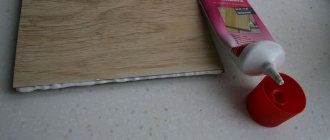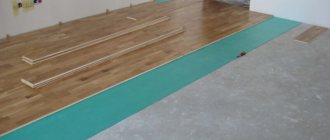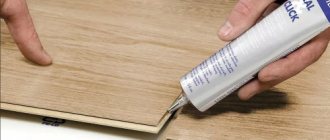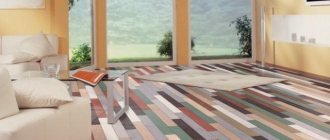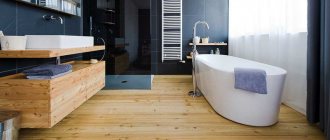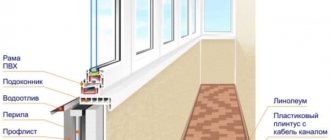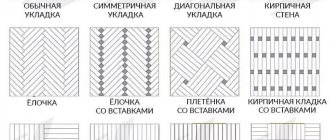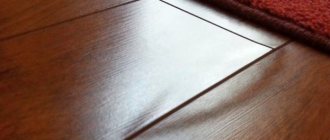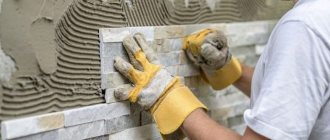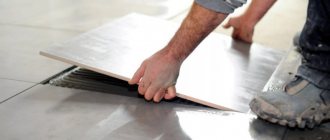Laminate is rightfully considered one of the most popular materials for flooring. Today it is used not only in apartments, but also in administrative buildings and office premises. The laminate looks attractive, has high strength characteristics, and is quite simple to install. But the material also has disadvantages – these include the vulnerability of the joints between the lamellas. In addition, scuffs and scratches may appear on the laminated surface over time. To preserve the attractiveness of the flooring for a long time, a special mastic for laminate flooring is used.
Mastic for laminate
What is mastic used for?
Laminate, despite its availability and practicality, has some disadvantages. For example, he does not “like” people walking on him in thin heels or dropping sharp objects on him, and does not tolerate high humidity in the room. Of course, there are types of laminate with increased strength and moisture resistance, but they, as a rule, cost much more than usual. For this reason, a simple laminate is usually used, which is not exposed to many negative factors.
Laminate layers
At the same time, you can protect even the cheapest laminate. Often wax or special mastic is used for these purposes. And to protect the joints from moisture, a special sealant is used.
Why do you need mastic for laminate flooring?
On a note! If you use a cheap laminate, you must first of all take care of protecting the joints, and immediately over the entire floor area. Due to the fact that the material is most susceptible to moisture, which tends to penetrate inside the boards through unprotected locks.
Table. About the use of laminate of different classes.
| Material class | Load | Where is it used? | Operational life, years |
| 21 | Low | Living rooms (living room, study) | 1-2 |
| 22 | Average | Living rooms (living room, children's room) | From 2 to 4 |
| 23 | High | Living rooms (kitchen, corridor) | From 4 to 6 |
| 31 | Low | Public rooms (for example, for negotiations) | From 10 to 12 |
| 32 | Average | Reception areas, office spaces | From 12 to 15 |
| 33 | High | Premises with high traffic (cafes, shops) | From 15 to 20 |
Special synthetic substances are used to make mastic, thanks to which it protects the lamellas from damage and increases their wear resistance. But note that mastic can be used to cover not only the surface of the material, but also the joints between the lamellas, so that moisture will not penetrate inside.
Mastic prevents moisture from entering the lamella
On a note! The first use of mastic should occur immediately after laying the floor covering. Therefore, it is recommended to buy it together with the laminate itself.
Mastic for laminate, parquet boards, parquet VALO
What to do in case of flooding
If there is a flood in your kitchen, take the following measures immediately.
- Wipe the slats dry.
- Remove the baseboards and remove all water under the backing.
- Check the panels for damage from contact with water.
- Laying the panels in place should be done a few days later, after they have completely dried.
- If it is impossible to correct the deformation of the panels, simply replace them.
To summarize, it can be noted that laying laminate flooring in the kitchen is a good idea. If installation technologies are followed, joints are protected, and with proper operation, it will last 20 years, pleasing with its aesthetics, ease of use, and practicality.
About characteristics and properties
Mastic has a number of properties, including:
- increasing the strength of board joints;
- protection of laid lamellas (including from moisture);
- return of color brightness;
- protection of the laminate from mechanical damage;
- keeping the coating clean for a longer time.
Thanks to mastic, the protection of the laminate from mechanical damage is increased.
Note! It is better to give preference to mastic that does not contain natural beeswax. After all, the properties of wax are such that it is hardly possible to distribute it evenly over the desired area without stains. And on laminate, such stains will be especially noticeable.
Bagi Mastic for floor protection
Despite the assurances of manufacturers that the laminate does not require any additional treatment, in reality it still needs to be protected. Although there are exceptions - expensive high-quality material, if it really has such protection. Mastic can significantly increase the service life of the laminate. The choice of different compositions is simply huge, their cost depends on the characteristics and the manufacturer, but on average it is about 200-1500 rubles. a piece. Also, do not forget that you should buy only high-quality mastic - this will minimize the risk of problems with the operation of the treated floor covering.
Prices for mastic for laminate flooring
mastic for laminate
Any wooden covering needs additional processing, including parquet
In addition to mastic, other compositions can be used for laminate. Let's consider their pros and cons, areas of application.
Protection against furniture damage
When dragging and installing furniture, it must be lifted and moved to a new place, and not dragged, dragging cabinets (sofas, tables, cabinets, etc.) along the floor. This, naturally, spoils the top coating of the laminate. But there are ways to protect your floor from mechanical damage.
Furniture leg protection
- Felt protective pads on an adhesive basis for furniture. This will prevent your feet from scratching the floor. The gaskets are securely attached to the lower surfaces of the furniture in contact with the floor.
- Plastic discs with soft fabric padding . If you need to rearrange bulky, heavy furniture, then this method will help you quickly cope with the task. Place the discs under the legs of the furniture and pull safely. The discs will allow you to easily and effortlessly move non-lifting furniture to the place you need by gently gliding across the laminate floor without damage. An alternative to discs is to use old thick blankets.
Plastic discs for furniture
It is ordinary chairs that cause great damage to the flooring.
To solve this problem and prolong the excellent appearance of the laminate, the following devices are used:
- Plastic caps-overlays : used as protection for the legs of heavy, oversized furniture that does not need to be moved frequently (sofas, massive armchairs, cabinets, sets, etc.).
- Rubber (silicone) furniture leg with an internal metal washer: used for the legs of chairs, armchairs, coffee tables.
Plastic caps and silicone feet
- Knitted socks for furniture from thick wool thread: give a playful mood and some uniqueness to your home. Mainly used for furniture in children's rooms. If you are a creative person and have free time, knit your own socks!
Options for “socks” for furniture legs
This will make your children happy and save money. You can also make socks from felt , or glue a wine cork cut to the shape to the legs.
Wheels on mobile furniture
Wheels on mobile furniture (computer chairs, carts, cabinets, coffee tables, etc.) differ in the type of material:
- made of rubber : practical, stable, can withstand loads of up to 400 kg, but sticky - with frequent use they leave black marks on any smooth floor covering;
- made of polyurethane : elastic and durable wheels with a load of up to 250-300 kg made of synthetic polymer, whose main characteristics are several times superior to rubber. They don’t leave marks, they hold up well (they don’t slip);
- made of plastic : the cheapest version of rollers, lightweight, inflexible. Due to the lack of friction, they will slide strongly across the laminate without scrolling and leaving worn-out scratches;
- made of polyamide (nylon): solid cast rollers, resistant to abrasion, adapt to the structure of the floor (that is, they behave equally on both smooth laminate (tile) and carpet).
Polyurethane roller for chair with metal protection
From all of the above, we can conclude that for use on laminate, wheels made of polyurethane or polyamide .
Silicone mats
Silicone non-slip mats . This is another option to protect your laminate flooring from premature wear.
Silicone mat
They are placed on the floor in places where pieces of furniture are frequently moved - mainly computer chairs or coffee tables on wheels. Silicone mats are transparent, which does not spoil the color interior of your room and adheres well to the surface of the laminate, withstanding a load of up to 100 kg.
Sealant
Using sealant, only the joints between the laid slats are protected from moisture. Ideally, you should use transparent silicone sealant - then the seams will be as invisible as possible. After treating the seams, moisture will no longer penetrate the material and cause its deterioration, which means its service life will increase.
Laminate sealant
The laminate must be laid on a flat surface, otherwise large differences may occur (the maximum permissible value is 2 mm per 1 sq. m.). And the larger they are, the wider the gaps between the boards will be, which is very bad. And if serious gaps cannot be avoided, then the interlocking joints must be treated with sealant during the process of laying the coating.
The sealant for laminate and parquet boards should form an adhesion to the sides of the joint without penetrating to the back surface
Important! Excess sealant that protrudes on the surface can be easily removed with a damp, soapy cloth.
Master Class. Using laminate sealant
As we just noticed, it is used during styling, not after it. You can buy any available sealant, there will be no difficulties in using it.
Step 1. First, open the tube and get ready to apply sealant to the interlocking joints of the slats.
First open the sealant
Step 2. Apply the compound to the outer part of the joint, evenly distributing it in a thick layer along the entire length.
The sealant is applied to the outside of the lock.
Step 3. Connect the boards to each other, click the lock.
Connection of lamellas
Step 4. See if excess composition has appeared on the surface. If yes, then you did everything correctly and the lock will lock.
Excess sealant has come out
Step 5. After about 10 minutes (check the manufacturer's instructions for the exact time), when the composition has polymerized, remove its excess.
At the end you need to remove the protruded sealant
Necessity of processing
Treatment of the laminate after installation is necessary to increase the service life. Despite the fact that the floor covering is synthetic, it requires additional treatment to increase the level of protection against moisture. In addition, another option is the restoration of old lamellas, which have seen a lot in their lifetime. Damage occurs when constantly walking on it, as well as when dragging furniture from place to place.
If you treat the lamellas in time with special means and materials, then not only will you not have to repair the laminate, but its service life will be significantly increased. In addition, moisture from the outside will no longer get inside through the seams and locking joints, which can cause serious damage to the floor covering.
Beeswax
We are talking about a special wax for laminate flooring that protects the material from the negative effects of environmental factors. For application, you can use a regular brush; it is better to do this while styling. Use tissues to remove excess. The thick wax that comes in a tube is applied in a thick and continuous layer, and the hardened excess is removed after the installation work is completed.
Wax for laminate
Peculiarities
Mastic is used on wood floors, which are the most difficult to maintain.
The use of such material has its pros and cons. You need to pay attention to them before you buy the product and treat the floor.
The excellent composition definitely refers to the advantages of mastic over other means. It contains wax or polymers to which household members will not be allergic. The composition of some materials is unique and contains antibacterial components
This is especially important if there are small children in the house who pull everything from the floor into their mouths. The wood is prone to wear, and the appearance after just a year is appalling. Mastic helps maintain the quality of the floor and improves sound insulation in the room
Mastic helps maintain the quality of the floor and improves sound insulation in the room.
Special mastic
It is used on undamaged laminate flooring to protect it from future damage. Mastic is sold both as a spray and as an emulsion. There are no difficulties with use - the material is simply rubbed into the surface (for example, using a sponge). Although the emulsion is more difficult to apply, it provides better protection for the slats.
It is better to apply the product with a sponge
Note! When applying mastic, make sure that no unattractive stains remain on the surface. As a rule, they appear due to poor rubbing of the composition (this must be done along the fibers of the laminate).
You need to apply the mastic carefully.
A water-based emulsion, by the way, is somewhat easier to rub in. Simply dilute it with water according to the instructions and apply to the floor covering. In other words, you will wash the floor with the prepared mixture and let it dry.
Important information! Interestingly, mastic is not only glossy, but also matte. Regardless of the type, mastic protects equally effectively. Here you just need to decide what the resulting gender should be.
Master Class. How to use mastic
Step 1. First, purchase mastic and carefully read the manufacturer's instructions. Then proceed to prepare the floor - sweep it, remove debris, wash it thoroughly and wait until it is completely dry.
Floor preparation
Step 2. Next, arm yourself with a sponge (you can take a small rag with a little lint) and mastic itself. Apply a little mixture to a rag to gradually treat the laminate.
Preparation for applying mastic
Step 3. Gently rub the mastic in, moving in the direction of the pattern. Make sure that there are no untreated areas or places where the composition has been applied poorly. Do everything in stages, that is, start from the far corner of the room and gradually move towards the exit.
Rubbing in mastic
Step 4. After finishing the treatment, wait for the mastic to dry and remove any excess by wiping the floor. It would seem that everything is extremely simple, but in reality it is painstaking work that requires a lot of time and effort.
The floor is wiped after the mastic has dried
Note! After completing the treatment, try not to walk on the coating for at least a few more hours.
Video - How to apply a water-based composition
Liquid formulations
If liquid mastic is chosen to repair the floor covering, it is applied with a wooden or plastic spatula. A metal tool can damage the defective surface even more.
One of the ways to polish mastic
The mastic is applied only to the damaged area. It is evenly distributed over the scratch, the excess is removed, wiped with a damp cloth and polished. Polishing can be done in any possible way:
- dry cloth;
- polish;
- polishing paste like “Goya”, etc.
In general, the algorithm for repairing laminate flooring with mastic does not change depending on whether it is liquid or solid. After repairs, you should not step on the repaired area of the floor for 5-6 hours.
How to remove scratches on laminate flooring?
Using mastic, you can not only treat the surface of the laminate, but also remove minor damage to it. Honestly, a special wax or pencil for laminate flooring will do a better job of this, but if you want to save a little money, you can get by with mastic. The latter should be dense (it’s more difficult to work with, especially since you’ll have to match the shade of the composition to the color of the laminate).
Laminate prices
laminate
Wax pencil for laminate
To eliminate damage, the mastic must be rubbed into the required area of the coating. Then the excess is removed and the surface is polished. You can use any lint cloth for polishing.
On a note! Use a spatula to apply thick mastic to the scratch.
Repairing scratches on laminate flooring
Before you choose
Buyers should, when choosing a laminate, find out whether the boards have been factory treated with mastic mixtures. Usually information about this is indicated on the label. If nothing is written, then you should consult with the seller before purchasing and laying the panels.
Repeated processing in such a situation is undesirable for several reasons:
- Firstly, the grout will be useless. It will not be possible to protect wood better than what is done in the factory.
- The second reason is that if you use the wrong composition, you can damage the factory coating. With further use of such a laminate, swelling, chips and other damage may occur.
How to seal joints between panels?
Just as with eliminating scratches on laminate, the mastic described in the article can also be used to seal joints between slats. Although in this case it is better to give preference to mastic that contains wax. The application process itself requires constant monitoring - you need to make sure that the product does not get on the surface and remain there (mastic should remain only in joints and locks).
Wax mastic
To treat the joints with mastic, use a small soft spatula, and quickly remove all excess - before the composition hardens - with a wet rag. Once you have finished applying the mastic, polish the laminate floor.
Important information! Experts recommend working with mastic only in a respirator (regardless of its type). The fact is that this is a very toxic composition that can lead to a deterioration in a person’s well-being. At the same time, after complete drying, the mastic is absolutely safe for both humans and animals.
Laminate flooring
Repair kit
Using a repair kit is a great way to deal with laminate flooring defects. The repair kit will save a lot of time. The set includes a spatula, a pencil and a special putty or putty. Advice, buy this set immediately when purchasing the laminate flooring itself. No one is immune from scratches, so the means to correct defects will always be at hand. They will not take up much space as they are quite compact.
How to make heating in the garage yourself
Advice: buy a repair kit immediately when purchasing the laminate flooring itself
The advantages of a repair kit include: the ability to use one or another type of product; Includes products in different colors; does not require professional skills.
Safety precautions when working with electrical equipment: general information and basic measures
Rules for caring for laminate flooring
To ensure that there are no cracks or other defects on the floor, you need to constantly monitor the laminate, remembering these important rules.
- For wet cleaning, use only warm water.
- If you polish laminate flooring, it can eventually become slippery, which can lead to injury.
- After each wash, water must be completely removed from the floor.
- Metal meshes and brushes should not be used to clean the floor.
- The same applies to abrasive products - they can leave scratches on the floor.
- Finally, alkalis and acids should also not be used.
Remember! Laminate is afraid of water, and therefore can swell due to frequent washing (this is most noticeable at the joints). To avoid this, wet cleaning should be carried out no more often than every 4 days.
How to properly wash laminate flooring
As for the mop, it should have a flat surface. The fact is that ordinary mops can leave scratches on laminate flooring. The ideal option is to use a washing vacuum cleaner.
To extend the service life of the coating, follow a few more simple rules.
Prices for laminate sealant
sealant for laminate
- You should not walk on laminate flooring in shoes, especially those with thin and high heels.
- You should always place special stands under vases with flowers.
- The legs of all pieces of furniture that can scratch the floor must be “disarmed” with special rubber caps.
- A damaged lamella can be replaced with a whole one, taken, for example, from under the bed, and the damaged one can be placed there.
- It is recommended to install mats in high traffic areas.
- Any spills on the floor must be cleaned up immediately, otherwise there will be a risk of damage to the laminate.
How can you wash laminate flooring
? If you use all these tips, you will preserve the original appearance of the coating for a long time!
Rules for cleaning laminate flooring
Laminate floor care
- Before starting wet cleaning, vacuum the floor and remove all visible dirt. It is strictly forbidden to use vacuum cleaners with rotating brushes - the upper protective coating of the slats will not withstand such pressure!
- Laminate flooring should be washed with warm water at a temperature of no more than 40-50 degrees Celsius;
- The attachment (rag) on the mop must be thoroughly wrung out;
- Laminate does not like the use of aggressive chemicals , so you cannot wash the floor with water containing chlorine, alkali, acid or ammonia. Also, any abrasives for cleaning the floor are prohibited. Only use soft fleece cloths for cleaning. You can pour a little dishwashing detergent into a bucket of water or purchase a special product for cleaning laminate floors in advance.
- Do not use steam mops to clean laminate flooring. Due to the high temperature of the steam and the high speed of its supply, the factory protective layer of the lamellas becomes unusable.
- After finishing cleaning, wipe the floor with a dry soft cloth.
Rules for applying rubber paint "AKTERM HydroStop"
Before applying mastic, it is important to make sure that the surface is dry, not prone to capillary rise of moisture, and has no traces of paint coatings, oils, grease and other substances that impede the quality adhesion of the waterproofing coating to the base. Rubber paint must be applied at a temperature of no less than +7 °C and no more than +45 °C, the layer thickness should not exceed 1 mm, the consumption in this case is 1.15 kg per square meter. The drying time of the applied layer is 24-48 hours at t>+15°C, after which it is possible to apply the next layer of waterproofing crosswise in relation to the previous one
The drying time of the applied layer is 24-48 hours at t>+15°C, after which it is possible to apply the next layer of waterproofing crosswise in relation to the previous one
Rubber paint must be applied at a temperature of no less than +7 °C and no more than +45 °C, the layer thickness should not exceed 1 mm, the consumption in this case is 1.15 kg per square meter. The drying time of the applied layer is 24-48 hours at t>+15°C, after which it is possible to apply the next layer of waterproofing crosswise in relation to the previous one.
The optimal thickness of the waterproofing layer is 2 mm. A correctly applied waterproofing layer is uniform, dense, without sagging. After the mastic has dried, you can install the heated floor, if planned, and lay the finishing floor covering.
Wood floor polishes
Mastic
Used for polishing wooden floors. It is available in the form of a ready-made product (usually in tin tubes) or a liquid that must be diluted with water in the required proportion. More expensive products contain wax. Budget analogues are special polymers. Mastics are used immediately after laying the floor covering and periodically (2-3 times a year) to protect the wood from mechanical damage, exposure to water and ultraviolet radiation.
Also, depending on the type, mastics are divided into:
- Hot Compositions are mainly used for block parquet. The base is bitumen or rubber. The mixture must be heated to 160 degrees before use. Not suitable for home use. They are highly flammable and harden quickly after heating, so experience is required to work with such compositions.
- Cold Suitable for use at home, does not require heating. The effect is achieved due to the content of solvents or alcohol, which evaporate and leave a protective film on the surface. The main disadvantage is its heavy, thick texture and long drying time - up to 3 days.
Important: cold mastics can be diluted, but when choosing a solvent, you should carefully study the manufacturer’s recommendations
- Colored and transparent Perform only protective functions. It is not possible to tint or return the original color to the floor. If the surface has severe abrasions, scratches, or the wood is faded (often happens in rooms located on the sunny side), tint compounds are used. After application, the color of the wood is evened out, and damaged areas are not so noticeable.
- Wax-based They have excellent protective properties and emphasize texture. Increases resistance to mechanical damage and protects against exposure to detergents during cleaning. Depending on the components included in the composition, after application the surface becomes glossy, semi-glossy or matte. The only but significant drawback is a specific and rather pungent odor that will linger in the room for several days. The composition is applied to the floor using a brush. After 7-9 hours, remove any remaining product using a clean cloth. Leave until completely dry for a few more hours. If necessary, apply a second layer.
- Water-based universal compositions that, in addition to protective, cleansing properties, thanks to the components included in the composition. They enjoy well-deserved popularity due to their affordable cost. Apply to the floor using a roller or brush and dry very quickly. Therefore, water-based mastics are an excellent solution for city apartments.
- Water-soluble They are used mainly for wood that is not afraid of moisture, such as oak. The composition is diluted with water in the proportion recommended by the manufacturer. If you plan to use mastic for other types of wood, you can add a little less water. But the composition in this case will be thicker. Water-soluble mastics cannot be used for polishing birch or beech floors, as they are very water-resistant.
Wax and wax polishes
Depending on consistency they are divided into:
- liquid – the easiest to use, it’s easy to treat even hard-to-reach places;
- pasty - more dense, applied with a spatula or a hard brush;
- hard - help to mask defects, scratches and select a shade, including for light wood species.
Wax polishes containing oils are also produced. They penetrate deeply into the wood structure and have good protective properties.
Important: before application, it is necessary to thoroughly remove contaminants. If you use oil first, product consumption will be reduced.
Compositions for laminate
To polish laminate flooring you need special products. Therefore, when purchasing, be sure to look at the composition and purpose - for what kind of coating the product is intended. High-quality polishes contain silicone, which forms a protective film on the surface. With regular treatment - 2.3 times a year, the polish can increase the life of the floor covering. It will give the coating a beautiful glossy shine and disguise scratches.
Laminate flooring care products are available in the form of sprays and mastics. The application technology is very simple:
- polish is applied to the clean floor;
- evenly distributed on the surface;
Afterwards, the composition is ground using a clean rag.
Purpose
Laminate is an artificial material for flooring, however, just like restoring wooden parquet, it requires the use of soft or liquid wax.
One of the purposes of gel wax for laminate is to treat joints. The seams between the slats are a vulnerable point, since moisture can penetrate through them. Wetting can occur both from the outside (during mopping or spilling liquid on the floor) and from the inside - in the form of condensation.
Laminate boards have a special protective water-repellent layer that does not allow liquid to pass through, but the joints do not have such protection
That is why it is very important, even while laying the laminate, to coat the seams with liquid wax, which will act as a sealant
Treating locks and joints with wax paste will also help avoid problems such as:
- creaking sounds of the coating;
- inconvenience of laying laminate;
- deformation of the coating under high loads.
The second important purpose of wax is the restoration of laminate flooring. Unfortunately, even the most expensive and high-quality laminate flooring begins to be damaged over time from various mechanical influences: scratches from heels and claws of pets, moving furniture, as well as heavy or sharp objects falling on the floor.
You can get rid of this kind of defects by using soft wax. This product is available for sale in wax pencil and wax crayon formats. You can find products in a variety of colors on the market, which makes it easy to choose a wax pencil that will perfectly match the color of your laminate flooring.
Using soft wax pencils and crayons, it is possible to make various damage to the laminate almost invisible, which allows you to extend the life of the floor covering.
This product has a number of other advantages:
- Lightness and ease of use - you can carry out restoration work on laminate flooring using a wax pencil with your own hands.
- Affordable price.
- Compact size and easy storage.
- Long service life.
- Large selection of different shades.
- This product is reusable.
- When working with a pencil, you do not need to use any auxiliary tools.
